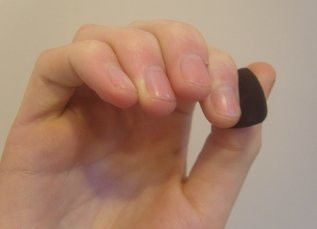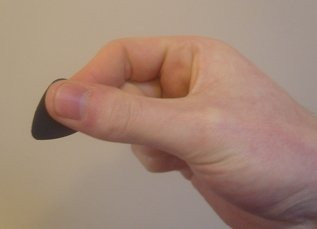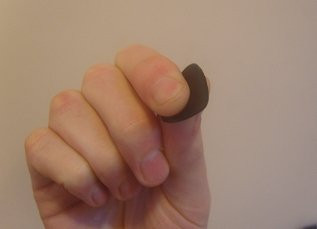Many guitarists, from beginners to seasoned players, often ponder the seemingly simple yet crucial aspect of guitar playing: how to hold a pick. If you’ve ever wondered if you’re holding your guitar pick correctly, or if a different grip could unlock a better tone and more fluid technique, you’re not alone. Even experienced players with decades under their fingers sometimes revisit this fundamental technique in pursuit of improvement.
You might have noticed online virtuosos, particularly in genres like blues and bluegrass, discussing how changing their pick grip revolutionized their playing. They often describe switching to a “fist” style grip, where the index finger curls parallel to the thumb, contrasting with the more common method of the index finger crossing perpendicularly beneath the thumb. Experimenting with this “fist” method can indeed produce a bolder, louder tone. However, it can also initially feel less controlled, especially when aiming for nuanced rhythm playing and precise string articulation.
So, is there a “correct” way to hold a guitar pick? Is this just a matter of personal preference, or does mastering this fundamental technique truly impact your guitar playing? Let’s explore the essential aspects of holding a guitar pick and how it affects your sound and technique.
Exploring Three Common Guitar Pick Grips
It’s important to understand that there isn’t one single “right” way to hold a guitar pick. Different grips offer varying degrees of control, tone, and flexibility, and the best choice often depends on your playing style, pick thickness, and musical genre. Let’s break down three primary methods:
1. The “O” Grip: A Balanced Approach
This is arguably the most popular and versatile method, often taught to beginners. The “O” grip achieves a balance between control and tonal expressiveness. Imagine forming an elongated “O” shape with your thumb and index finger. The pick is held between the side of your thumb and the side of your index finger’s first knuckle.
 Close-up of the "O" guitar pick grip from the player's perspective, showing the thumb and index finger forming an elongated O shape around the pick.
Close-up of the "O" guitar pick grip from the player's perspective, showing the thumb and index finger forming an elongated O shape around the pick.
 Side view of the "O" guitar pick grip, highlighting the gentle curve of the index finger and thumb holding the pick.
Side view of the "O" guitar pick grip, highlighting the gentle curve of the index finger and thumb holding the pick.
Advantages of the “O” Grip:
- Versatility: Well-suited for both rhythm and lead playing across various genres.
- Control: Offers a good level of precision for accurate picking and articulation.
- Tone: Produces a balanced tone, neither too bright nor too dull.
2. The “Pinch” Grip: Flexibility for Strumming
The “pinch” grip emphasizes flexibility and is often favored by guitarists who primarily strum, especially with lighter gauge picks. In this method, the pick is held more loosely between the thumb and the flat of the index finger, rather than the side.
 Top-down view of the "pinch" guitar pick grip, demonstrating how the pick is held between the thumb and the flat part of the index finger.
Top-down view of the "pinch" guitar pick grip, demonstrating how the pick is held between the thumb and the flat part of the index finger.
 Angled view of the "pinch" guitar pick grip, showing the relaxed hand position and the pick held with less finger curl.
Angled view of the "pinch" guitar pick grip, showing the relaxed hand position and the pick held with less finger curl.
Advantages of the “Pinch” Grip:
- Flexibility: Allows for greater pick movement, ideal for strumming and rhythmic patterns.
- Light Touch: Suitable for delicate playing and lighter gauge picks.
- Smooth Strumming: Facilitates smooth, flowing strumming patterns.
3. The “Fist” Grip: Power and Attack
The “fist” grip, sometimes called the “flat pick” or “bluegrass grip,” is often associated with players who use heavier gauge picks and seek a powerful, direct tone. In this grip, the index finger is curled more significantly, often parallel to the thumb, creating a firmer hold.
 Close-up of the "fist" guitar pick grip from the player's perspective, showing the index finger curled tightly parallel to the thumb.
Close-up of the "fist" guitar pick grip from the player's perspective, showing the index finger curled tightly parallel to the thumb.
 Side view of the "fist" guitar pick grip, highlighting the more closed fist position and the firm hold on the pick.
Side view of the "fist" guitar pick grip, highlighting the more closed fist position and the firm hold on the pick.
Advantages of the “Fist” Grip:
- Power: Produces a stronger, louder tone with more attack.
- Control with Heavy Picks: Works well with thicker picks, offering stability.
- Aggressive Styles: Favored in genres like bluegrass, rock, and metal for its assertive sound.
Finding the Right Grip for You: Experimentation is Key
Ultimately, the “best” way to hold a guitar pick is subjective and highly personal. It’s about finding a grip that feels natural, comfortable, and allows you to achieve your desired tone and technique. Here’s how to navigate this process:
1. Experiment with Pick Gauges: Pick thickness significantly influences how a grip feels and sounds. Lighter picks are more flexible and produce a brighter tone, while heavier picks offer more stiffness and a warmer, fuller sound. Try a range of pick gauges, from thin (.38mm) to heavy (1mm+) to understand how they interact with different grips.
2. Consider Your Playing Style and Genre: If you primarily strum acoustic rhythms, the “pinch” grip with a lighter pick might be ideal. If you play fast lead lines or aggressive riffs, the “O” grip or “fist” grip with a medium to heavy pick could be more suitable. Think about the musical styles you enjoy and the techniques you use most often.
3. Don’t Discount Muscle Memory: If you’ve been playing with a particular grip for a long time, changing it can feel awkward and set you back temporarily. While experimentation is valuable, remember that consistent practice with any grip will lead to improvement over time. Drastically changing your grip after years of playing might require significant adjustment and may not always be necessary unless you’re experiencing specific limitations.
4. Short-Term Experimentation for Long-Term Gains: Dedicate a few days to actively experimenting with the three grips described above, along with different pick gauges. During your practice sessions, play songs and exercises you already know well, focusing on how each grip feels and sounds. This focused experimentation will help you quickly identify grips that feel unnatural or limit your playing.
5. Choose a Grip and Commit: After your experimentation period, you’ll likely find one or two grips that feel most promising. If you’re torn between options, choose one and stick with it. Consistent practice with a chosen grip will allow your muscle memory to develop, and you’ll naturally adapt and refine your technique over time.
Conclusion: Your Pick Grip is a Personal Voice
Finding the right way to hold a guitar pick is a journey of discovery. While there are common methods and general guidelines, the optimal grip is ultimately the one that empowers you to express yourself musically. Experiment, listen to your tone, and prioritize comfort and control. Once you find a grip that resonates with you, trust your instincts, commit to it, and focus on making music. Don’t get bogged down in endlessly searching for the “perfect” grip – the most important thing is to play and enjoy your guitar!

